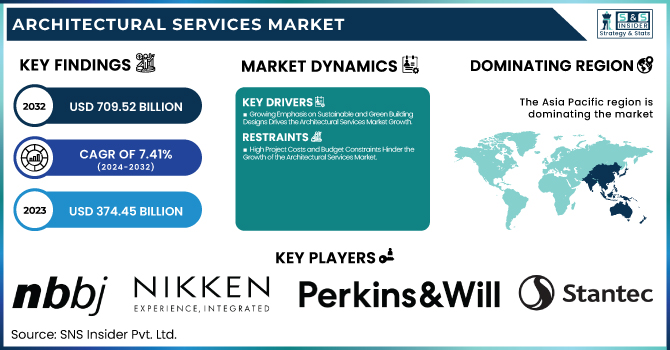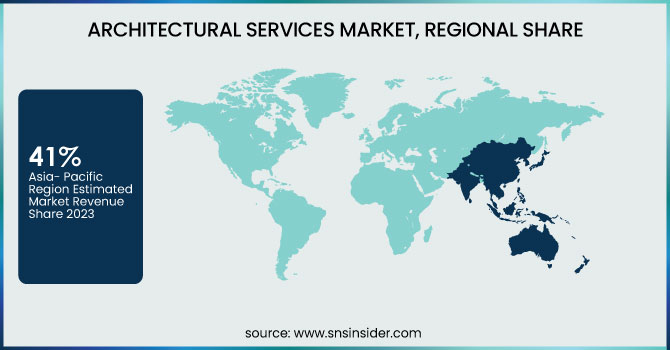Architectural Services Market Report Scope & Overview:
The Architectural Services Market Size was valued at USD 374.45 Billion in 2023 and is expected to reach USD 709.52 Billion by 2032 and grow at a CAGR of 7.41% over the forecast period 2024-2032.

To Get more information on Architectural Services Market - Request Free Sample Report
The Market includes market demand trends, investment patterns, revenue share by service type, profit margins, pricing analysis, employment statistics, technological adoption rates, client spending behavior, regulatory impact assessments, and project turnaround time analysis. These metrics highlight the rise of sustainable designs, funding trends, cost variations, workforce growth, AI and BIM adoption, and regulatory impacts. Understanding client spending behavior and project efficiency further refines market strategies. Together, these factors provide a comprehensive view of industry dynamics, shaping decision-making for stakeholders and driving architectural innovation.
Architectural Services Market Dynamics
Key Drivers:
-
Growing Emphasis on Sustainable and Green Building Designs Drives the Architectural Services Market Growth
The rising focus on sustainability and eco-friendly architecture is a significant driver of the Architectural Services Market. Governments worldwide are enforcing stringent environmental regulations, pushing the adoption of energy-efficient designs, smart buildings, and green infrastructure. Consumers and businesses are also prioritizing sustainability, leading to increased demand for LEED-certified and net-zero energy buildings.
Technological advancements like Building Information Modeling (BIM) and AI-driven design optimization further enhance sustainable construction practices. Additionally, rising urbanization and the need for climate-resilient structures contribute to market expansion. As sustainability becomes a top priority, architecture firms integrating green solutions will gain a competitive advantage in the evolving landscape.
Restraint:
-
High Project Costs and Budget Constraints Hinder the Growth of the Architectural Services Market
The architectural services industry faces significant challenges due to the high costs associated with design, materials, and labor. Many businesses and governments struggle with budget limitations, leading to project delays, downsizing, or cancellations. Advanced architectural solutions, such as sustainable materials and smart technology integration, often come with a premium price, making them less accessible to budget-conscious clients.
Additionally, fluctuating construction costs and economic uncertainties impact investment in architectural projects. The challenge of balancing cost-effectiveness with design innovation puts pressure on firms to optimize resources while delivering high-quality services. These financial barriers can slow market growth and limit the adoption of advanced architectural solutions.
Opportunities:
-
Technological Advancements in AI and Automation Create Lucrative Opportunities for the Architectural Services Market
The rapid integration of artificial intelligence (AI), automation, and advanced digital tools presents vast opportunities for the architectural services industry. AI-powered design software streamlines workflows reduces human error, and enhances precision in project planning. The rise of generative design, 3D printing, and virtual reality (VR) allows architects to visualize and modify projects more efficiently.
Automation in project management also improves operational efficiency, reducing costs and timelines. Additionally, smart city initiatives and digital twin technology are driving demand for tech-enabled architectural services. Firms that leverage these innovations can enhance their service offerings, improve productivity, and capture emerging market opportunities.
Challenges:
-
Stringent Regulatory Compliance and Zoning Laws Pose Challenges to the Architectural Services Market
Regulatory compliance and zoning laws present significant challenges for the architectural services industry, often causing project delays and increased costs. Governments worldwide enforce complex building codes, safety regulations, and environmental standards that architects must strictly follow. Compliance with these ever-evolving regulations requires extensive documentation, permits, and approvals, leading to prolonged project timelines.
Additionally, zoning laws can restrict design possibilities, impacting innovation and feasibility. International projects also face varying regulatory frameworks, creating additional hurdles for global architectural firms. Navigating these legal complexities demands specialized expertise and increases operational costs, making it a persistent challenge for industry players to ensure compliance without compromising efficiency.
Architectural Services Market Segments Analysis
By Type
The Construction and Project Management Services segment dominates the Architectural Services Market, holding the largest revenue share of 32% in 2023. The increasing complexity of construction projects, growing infrastructure development, and the rising adoption of digital project management tools have fueled this segment’s expansion. Major industry players are integrating AI-driven project management, cloud-based collaboration platforms, and real-time tracking solutions to enhance efficiency and cost-effectiveness.
For example, AECOM launched its Digital AECOM initiative, focusing on smart infrastructure and data-driven project management, improving delivery timelines and sustainability. Additionally, Jacobs introduced advanced BIM-based project planning to optimize construction workflows.
The Legal Technical Requirement Compliance Counseling Services segment is growing at the highest CAGR of 8.74%, driven by stricter building codes, environmental regulations, and safety standards. As global construction and architectural projects expand, the need for specialized compliance consulting is increasing to navigate complex zoning laws, fire safety codes, accessibility requirements, and environmental impact assessments. Leading companies are enhancing their compliance services to meet evolving industry demands.
For instance, Stantec expanded its regulatory advisory services, offering advanced compliance solutions for green architecture and sustainable design. Similarly, Gensler introduced AI-powered code analysis tools, streamlining permit approvals and compliance checks.
By End-Use
The Industrial segment dominates the Architectural Services Market, holding a 39% revenue share in 2023, driven by rapid industrialization, manufacturing expansion, and smart factory adoption. The rising demand for sustainable industrial facilities, energy-efficient warehouses, and high-tech manufacturing plants has propelled the need for specialized architectural services. Companies are focusing on green building designs, advanced automation, and modular construction to enhance efficiency and reduce environmental impact.
For instance, AECOM introduced AI-powered industrial facility design solutions, optimizing production workflows and space utilization. Similarly, Foster + Partners unveiled net-zero carbon manufacturing plants, integrating renewable energy and sustainable materials.
The Education segment is experiencing the fastest growth within the Architectural Services Market, with a 9.02% CAGR, fueled by rising investments in modern learning spaces, digital integration, and sustainable school infrastructure. Governments and private institutions are prioritizing student-centric designs, smart classrooms, and energy-efficient campus expansions to enhance the learning environment. Architectural firms are developing flexible, technology-driven educational facilities to support new-age learning models.
The push for green architecture in schools and universities is driving demand for LEED-certified campuses, solar-powered classrooms, and eco-friendly building materials. In addition, the increasing integration of smart technologies, digital libraries, and collaborative learning spaces requires advanced architectural planning to create interactive and future-ready environments.
Regional Analysis
The Asia Pacific region led the Architectural Services Market in 2023, holding an estimated 41% market share, driven by rapid urbanization, infrastructure expansion, and smart city initiatives. Governments across China, India, Japan, and Southeast Asia are heavily investing in residential, commercial, and industrial construction, fueling demand for architectural services.
For instance, China's "New Infrastructure" plan focuses on green buildings, smart cities, and digital transformation in construction, boosting the need for advanced architectural solutions.
Additionally, India’s Smart Cities Mission has led to increased architectural innovation, with firms like Stantec and AECOM actively contributing to urban development projects. The rise of eco-friendly and energy-efficient buildings further accelerates market growth, with companies such as Foster + Partners designing sustainable urban landscapes in Asia. The booming real estate, hospitality, and healthcare sectors also contribute to the dominance of this region.
North America is the fastest-growing region in the Architectural Services Market, with an estimated CAGR of 8.5% in 2023, driven by sustainability initiatives, smart infrastructure projects, and technological advancements. The rising demand for LEED-certified green buildings, smart homes, and AI-integrated architectural planning is fueling growth across the United States and Canada.
The U.S. Infrastructure Investment and Jobs Act (IIJA) has significantly boosted architectural activities, funding large-scale projects such as transportation hubs, energy-efficient buildings, and urban revitalization plans. Additionally, the increasing adoption of BIM (Building Information Modeling) and AI-driven design software by firms like Jacobs and HOK has enhanced efficiency and project execution speed. The booming real estate, corporate, and institutional construction sectors further support market expansion.

Get Customized Report as per Your Business Requirement - Enquiry Now
Key Players
Some of the major players in the Architectural Services Market are:
-
NBBJ (Healthcare Design, Workplace Strategy & Design)
-
Nikken Sekkei Ltd. (Urban Redevelopment Projects, Sustainable Architectural Solutions)
-
Perkins and Will (Educational Facility Design, Healthcare Architecture)
-
Perkins Eastman (Senior Living Design, Mixed-Use Developments)
-
Stantec (Infrastructure Planning, Smart City Solutions)
-
Zaha Hadid Architects (Parametric Design, Cultural & Civic Architecture)
-
AECOM (Mega Infrastructure Projects, Sustainable Urban Planning)
-
CannonDesign (Healthcare Planning, Sports & Recreation Architecture)
-
Foster + Partners (High-Rise Commercial Buildings, Sustainable Architecture)
-
Gensler (Corporate Workplace Design, Retail & Hospitality Architecture)
-
HDR, Inc. (Transportation Infrastructure, Healthcare & Research Facilities)
-
HKS Inc. (Sports Venue Design, Hospitality & Resort Architecture)
-
HOK (Aviation & Transportation Design, Science & Technology Facilities)
-
IBI Group (Smart Cities & Mobility Solutions, Educational Facilities Design)
-
Jacobs (Government & Defense Infrastructure, Environmental & Sustainability Consulting)
Recent Trends
-
In September 2024, NBBJ completed the Ohana Behavioral Health Campus in California. Designed to integrate natural elements, the facility is enveloped by oak trees, rosemary, and lavender plants. Floor-to-ceiling windows provide 94% of the 16-resident facility with views of surrounding hills and mountains, creating a welcoming environment that contrasts with typical clinical settings.
-
In October 2024, Perkins&Will finalized the Museum of Shakespeare in Shoreditch, London. This new museum showcases the archaeological remains of Shakespeare's Curtain Playhouse, believed to be the original stage for "Romeo & Juliet" and "Henry V." The museum serves as the centerpiece of The Stage, a mixed-use urban development in the area.
| Report Attributes | Details |
|---|---|
| Market Size in 2023 | US$ 374.45 Billion |
| Market Size by 2032 | US$ 709.52 Billion |
| CAGR | CAGR of 7.41 % From 2024 to 2032 |
| Base Year | 2023 |
| Forecast Period | 2024-2032 |
| Historical Data | 2020-2022 |
| Report Scope & Coverage | Market Size, Segments Analysis, Competitive Landscape, Regional Analysis, DROC & SWOT Analysis, Forecast Outlook |
| Key Segments | • By Type (Architectural Advisory Services, Construction and Project Management Services, Engineering Services, Interior Design Services, Urban Planning Services, Building Code Counseling and Interpretation Consulting Services, Legal Technical Requirement Compliance Counseling Services, Others) • By End-Use (Education, Government, Healthcare, Hospitality, Residential, Industrial, Retail, Others) |
| Regional Analysis/Coverage | North America (US, Canada, Mexico), Europe (Eastern Europe [Poland, Romania, Hungary, Turkey, Rest of Eastern Europe] Western Europe] Germany, France, UK, Italy, Spain, Netherlands, Switzerland, Austria, Rest of Western Europe]), Asia Pacific (China, India, Japan, South Korea, Vietnam, Singapore, Australia, Rest of Asia Pacific), Middle East & Africa (Middle East [UAE, Egypt, Saudi Arabia, Qatar, Rest of Middle East], Africa [Nigeria, South Africa, Rest of Africa], Latin America (Brazil, Argentina, Colombia, Rest of Latin America) |
| Company Profiles | NBBJ, Nikken Sekkei Ltd., Perkins and Will, Perkins Eastman, Stantec, Zaha Hadid Architects, AECOM, CannonDesign, Foster + Partners, Gensler, HDR, Inc., HKS Inc., HOK, IBI Group, Jacobs. |

